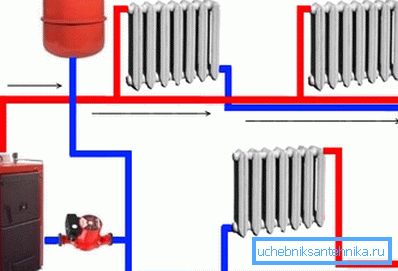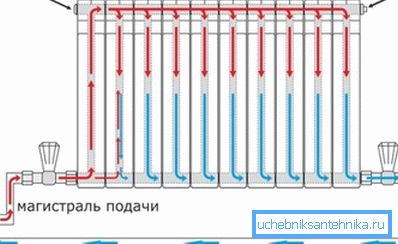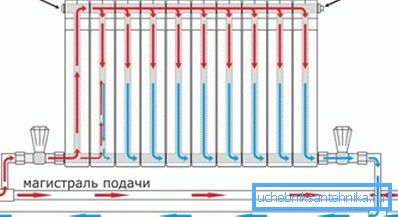Connecting a heating radiator to a two-pipe system: types of
Typically, the heating system in private homes is autonomous, so for its organization it is required to purchase a boiler of sufficient power and determine what the heat transfer from radiators should be. Then it remains for the small - all you need to do is to connect the heaters to the boiler with the help of the pipeline and fill all with coolant. The most optimal connection scheme is a two-pipe, when there is a flow and return flow.

Types of heating systems
Use single-pipe and two-pipe versions, which may have both advantages and disadvantages. The design can be mounted both with the lower wiring and with the top. However, the latter is used most often, as it is more convenient and practical.
As you know, the principle of operation of an autonomous heating system is the constant circulation of water or other coolant from the boiler to the devices and back. However, it can move by gravity, or by force, which is achieved by connecting the pump.

Two-pipe connection option
Consider its features:
- The installation manual of the scheme implies the presence of two separate pipelines to which each of the devices is connected.
- At the same time, one water supply system is a supply pipe, from where hot water flows, and the other is a reverse one, which dispenses already cooled water.
- Since the paths that are overcome by the coolant, both in the supply pipe and in the return, are equal, their hydraulic resistance is the same. That is, such a scheme is hydraulically balanced, which makes its application the most optimal.

Tip: the use in this case of the diagonal method of connecting heating devices will make the system more efficient.
- However, the schemes can be dead-end, which means that the most:
- a long way is made by the already cooled water leaving the last in the heating appliance chain;
- short - runs from the first.
For this reason, you will have to adjust the flow of hot water with your own hands in each of the battery taps or use thermostatic valves.
Layout
The scheme can be forced (built-in pump) and self-flowing, the main advantage of the latter is that it does not require electricity. To do this, the upper wiring is done, and the heating devices, as well as in the previous case, are connected diagonally.

It is used most often in small residential buildings that have no more than two floors. Although it will be ideal in settlements experiencing power outages, it is not often used, which is explained by the need to use a large amount of materials and an unaesthetic appearance.
It is used not only in residential buildings, but also in any other buildings, regardless of their purpose. Her organization requires a lot of materials and effort, but the advantages of such a system are indisputable.

Tip: you can easily pick it up for any buildings, no matter how complex they are.
On one branch, a large number of heating devices may be located, and this does not require additional installation of hydraulic pressure regulators. Water supply and reverse outflow in such schemes are connected separately, which allows you to adjust the heating of all rooms in the house automatically. In this case, the thermostats will not have any effect on other devices, and their price will only slightly increase the cost of installation.

Options for connecting heaters to the system
We often say the words “connect” and “connect”, implying the performance of the same action — connect the radiator to the piping of the heating system.
However, this approach is amateurish, since there is a certain technical difference between them:
- connect radiator - bring the flow line and the return pipe to it. An example would be the lateral version of the radiator, when pipes fit the device from one side above and below, or diagonal.
- connect the heating device - create a connection unit in which there is a supply or return flow, as well as regulating ball valves, valves or other similar elements.
There are two main options for the heating system, on which the final assembly of the heating scheme of the house or apartment depends:
- Upper - supply line is located above the upper level of the radiator. In this case, use the following options for attaching a radiator:
- unilateral lateral (from below and from above) - the method is most effective when using in the battery no more than 10 sections. Otherwise, the warm-up of the distant occurs not completely, because of which the efficiency of the device is significantly reduced;

- Diagonal (top and bottom) can be two ways, each of which is considered the most effective with this method of wiring. You can use devices with more than 10, the number of sections and they will warm up as much as possible.
- The lower - supply line comes to the radiator from the bottom, usually used when installing the pump:
- unilateral lateral (top and bottom) - in this case, as in the previous one, the maximum effect of this method can be obtained only with the number of sections in heating devices no more than 10, otherwise the coolant simply does not have time to heat them;

- diagonal (top and bottom) - the effect is the same as with the upper wiring;

- lower way - in this case, the flow comes from the bottom to the radiator and goes out the other side, too, from the bottom. The greatest effect will be only when installing the pump;


Tip: make the filing and return loop more than the last radiator installed with extreme caution, otherwise it may affect the setting of the entire heating system.
Consider:
- with the top wiring, you will get the maximum effect with diagonal connection of devices;
- with the lower wiring and the pump the most effective option will be the bottom (bottom-bottom).
Conclusion
As can be seen from the article, the two-pipe version of connecting radiators to the heating system is the most acceptable one from almost all points of view, with the exception of an increase in the cost of components. They allow you to easily adjust the temperature of the coolant for different rooms, as well as to make the necessary balancing to prevent a hydraulic shock.
Installation of heating devices to the scheme is not difficult, so in private houses it is usually done independently. The video in this article will provide an opportunity to find additional information on the above topic.